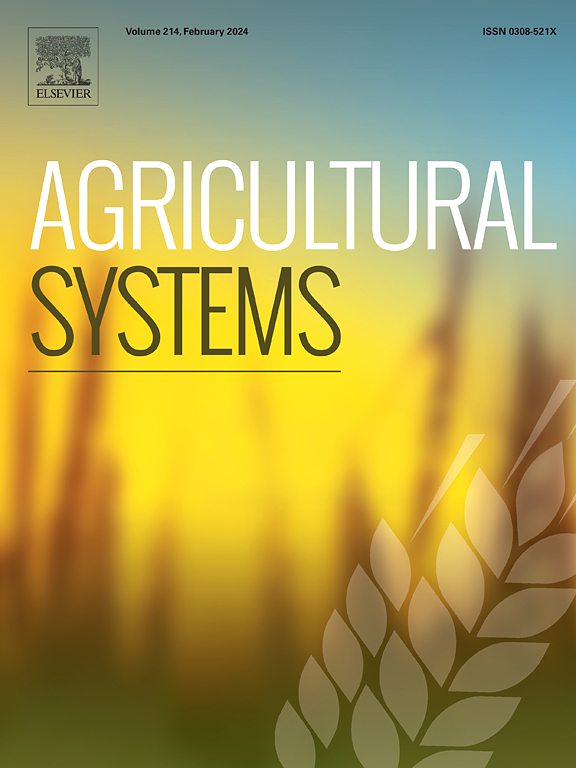Experimentation and model-based re-design for sustainable intensification of mixed crop-livestock smallholder farms in the Mixteca-Oaxaqueña region, Mexico
IF 6.1
1区 农林科学
Q1 AGRICULTURE, MULTIDISCIPLINARY
引用次数: 0
Abstract
CONTEXT
Redesign of farm systems could enable smallholder farms to move towards sustainability. In farm redesign, the joint participation of researchers and farmers is fundamental, together with new techniques and tools for evaluation.
OBJECTIVE
To apply and analyze the redesign mixed crop-livestock smallholder farms in the Mixteca-Oxaqueña region, Mexico, based on models and participatory experimentation, to propose more sustainable farm management alternatives.
METHODS
Three mixed crop-livestock smallholder farms in the Mixteca-Oxaqueña region were redesigned, using models and participatory experimentation to test and assess more sustainable management alternatives. We used the FarmDESIGN model, which was parameterized, and allowed for the evaluation of the farms before and after on-farm experimentation with innovative cropping systems. The experimentation was co-designed based on an exploratory phase of pilot-experiments and in-depth discussions with farmers about the results, providing elements for the re-design of farms towards sustainability. The experiment results were inputs for the model to generate new alternatives. The cropping system experiments were conducted in collaboration with farmers over a two-year period. They consisted of i) polyculture with maize (Zea mays) and beans (Phaseolus vulgaris), ii) fodder mixture of oats (Avena sativa) and common vetch (Vicia sativa), and iii) improved fertilizer use for maize.
RESULTS AND CONCLUSIONS
In the initial evaluation, the three analyzed farms showed precarious profitability with an annual income (profits) of USD$200 to USD$1000. The three farms had food autonomy and excess, and per hectare, covered the annual food requirements of 2 to 4 people. Proposals for the final design of the systems were based on explorations using data from the experiments. The proposed redesign responded to the need to increase income and improve the balance of organic material and nitrogen and to reduce greenhouse gas emissions. The proposals focused on increasing the sale of animals, reducing herd size, promoting grazing on farms, producing forage with irrigation in the dry season, and rational fertilization for the tomato, bean, and maize crops, considering their sales. Nevertheless, in addition to reconfiguring the farm systems, public policies are necessary that create distribution mechanisms for the food produced and new value chains are necessary, as well as the provision of technical support for animal management, and fertilization schemes for high commercial value crops for human and animal consumption.
SIGNIFICANCE
This study successfully included the interaction with farmers and the combination of an experimental and model-based analysis. We were able to adapt to the current conditions of the study area by working individually with each of the three farms. These farms are nevertheless indicative and provide elements for agrosystem redesign for greater agricultural activity in the region. New configurations resulting from the farm modeling and experimentation responded to the need to increase income and food autonomy, without increasing the environmental impact and labor.

求助全文
约1分钟内获得全文
求助全文
来源期刊

Agricultural Systems
农林科学-农业综合
CiteScore
13.30
自引率
7.60%
发文量
174
审稿时长
30 days
期刊介绍:
Agricultural Systems is an international journal that deals with interactions - among the components of agricultural systems, among hierarchical levels of agricultural systems, between agricultural and other land use systems, and between agricultural systems and their natural, social and economic environments.
The scope includes the development and application of systems analysis methodologies in the following areas:
Systems approaches in the sustainable intensification of agriculture; pathways for sustainable intensification; crop-livestock integration; farm-level resource allocation; quantification of benefits and trade-offs at farm to landscape levels; integrative, participatory and dynamic modelling approaches for qualitative and quantitative assessments of agricultural systems and decision making;
The interactions between agricultural and non-agricultural landscapes; the multiple services of agricultural systems; food security and the environment;
Global change and adaptation science; transformational adaptations as driven by changes in climate, policy, values and attitudes influencing the design of farming systems;
Development and application of farming systems design tools and methods for impact, scenario and case study analysis; managing the complexities of dynamic agricultural systems; innovation systems and multi stakeholder arrangements that support or promote change and (or) inform policy decisions.
 求助内容:
求助内容: 应助结果提醒方式:
应助结果提醒方式:


